The guide to morning dress: Part two, cut and make
By Aleks Cvetkovic
Welcome to the basted fitting for the bespoke morning suit by Whitcomb & Shaftesbury that we referenced in the first instalment of this series.
As mentioned previously, the coat is cut in traditional black featherweave worsted, the waistcoat seen here is in fitting cloth (the actual dove grey gabardine chosen can be seen below) and the trousers are a distinctive, mid-grey marled cashmere stripe.
The striped trouser cloth is perhaps the most interesting choice of the three. On the advice of morning-wear guru Chris Modoo, I chose a lighter, richly textured trousering over the flatter, darker grey stripe that is commonly used for morning dress. This slightly paler cloth has more character, and it contrasts with the coat while harmonising with the waistcoat at the same time.
Both coat and trouser cloths are from Smith Woollens’ ever-dependable Formalwear bunch, while the waistcoat cloth (a twill, rather than the more traditional plainweave) is from Holland & Sherry. The latter has a lovely drape and a saturated tone to the dove grey, which is nicer than other pale greys we looked at.
The black featherweave has a smooth handle and subtle sheen, which is really lovely too. It’s 12oz in weight, which is heavier than conventional summer cloths, but morning coats don’t really make-up well in thin fabric.
But why these colours, let alone the fabrics? Let’s start with the decision to go for a black coat and cashmere-stripe trousers, as opposed to a three-piece morning grey.
As discussed in Part One, morning dress isn’t a dress code to push boundaries with. Rather, there’s a huge amount of pleasure in playing with its subtle nuances and archaisms. While I’d have loved to experiment with a morning grey, a black morning suit is appropriate for any formal occasion and the safest place to start.
I also think that Whitcomb & Shaftesbury’s finishing is second to none, and the thought of trimming the morning coat’s lapels and cuffs with black silk braid clinched the deal.
I chose dove grey for the waistcoat because I find buff a little dull, and didn’t want to wear a sky blue waistcoat with a blue shirt underneath. Pink linen or cream worsted would have been fun, but I felt these were perhaps colours to experiment with at a later date.
In terms of make, the suit is being made using Whitcomb & Shaftesbury’s signature Classic Bespoke service, where the garment is cut and fitted in London, and tailored in India. All my pieces from W&S have been made this way, from a tweed ulster coat to my olive-velvet smoking jacket, and the results have been consistently excellent.
I have very little time for those who are snobby about where in the world a bespoke garment is made. Skilled artisans are to be found all over, and some of the best pieces I’ve seen or tried have come from tailors working in unexpected places. Edward Sexton’s Offshore Bespoke service is another good example of how well this hybrid approach to cutting and tailoring can work.
Whitcomb’s tailoring is made at the house’s own dedicated workshop in Chennai, where Suresh and Mahesh have gone to great lengths to provide ethical, gainful employment for local craftspeople. The workshop is a co-operative and staff benefit from perks like free education for their children and competitive, secure salaries (as opposed to piece payment, which is more common in India).
Whitcomb’s Bob Bigg, who’s helped to advise on the styling of my morning suit throughout the process, flies out to Chennai regularly to manage quality control and train the workshop’s staff, and the results speak for themselves. These pictures show the coat coming to life in Chennai under Bob’s supervision.
Cutting a morning coat is, as you might imagine, a technical feat – even with what Sian and Richard delightfully call a repeat client’s “mature” pattern, like mine.
One of the most obvious challenges is getting the coat’s balance right, while ensuring the coat snugly follows the shape of the wearer’s spine. Sian explains how the pattern accommodates this: “The morning coat is a type of body coat (like a frock coat or tailcoat), derived from traditional riding coats. Body coats have additional side panels cut into the back, compared to a lounge suit. This creates two extra darts through the back waist that can be suppressed in order for the coat to fit closer into the spine.
"Extra back balance (length in the back) is added to the pattern to help with this close fit. This extra balance also helps to control the coat’s skirt and keeps the tails from kicking out.”
Sian explained to me that a morning coat’s panelled construction is also a challenge – although it does give a skilled cutter options to tweak the silhouette.
I’d always assumed the horizontal centre seam of a morning coat is a straight line around the body, but it’s actually cut with a subtle curve from the spine around, up and over each hip, which is accentuated by shrinking and working the cloth with an iron.
This clever bit of wizardry helps the coat to hug the wearer right around the body, and helps the back of the coat to hit the small of the spine. You can see from the fitting snaps that we experimented with the coat’s waist and balance, and we’ve also decided to nudge out the lapels another centimetre or so in-line with my predilection for full lapels.
Suresh pointed me to some of the coat’s other thoughtful details.
Whitcomb & Shaftesbury forego the traditional padding that commonly featured in early 20th century morning coats for the sake of weight and comfort, but they do sew two discreet hip pads into the side of each coat tail, just below the waistline. These help your tails sit neatly over the seat – especially if yours is ‘prominent’ like mine.
The tails themselves feature a slim hidden pocket between the outer cloth and lining to keep your chamois gloves in. I don’t plan to wear gloves with my morning suit; they’re one of those accessories that feels a little bit ‘dress up’ to me, but it’s a lovely feature to retain nonetheless.
The fitting of the waistcoat and trousers were both straightforward; my trouser pattern in particular is spot on at Whitcomb & Shaftesbury.
You’ll notice the brace-top trousers are as high-waisted as can be, and finished with a nod towards a fish-tail back. We’re foregoing side adjusters on these, because I’ll only ever wear them with braces and they will look cleaner without.
Single forward-facing pleats and on-seam pockets are both common details for morning trousers, although as mentioned previously, there are fewer prescriptions than you might think for how a morning trouser should be tailored.
We’re going to taper the trousers just a touch from the knee downwards. They felt a little bit swishy at the fitting, and a slightly narrower leg will complement the coat’s clean lines. The waistcoat length is also coming down just a touch to ensure the trouser waistband is always covered, but no other changes were necessary. The waistcoat’s lapels are coming out a little too, as with the coat, but that’s purely to satisfy my own tastes.
In the third and final instalment of this series we’ll talk about the finished suit, some key styling decisions that are worth keeping in mind with your own morning dress, and where I sourced the other elements of the finished outfit.
Till then,
A
Fabrics:
- Coat: 13oz, Smith Woollens Formalwear bunch: 7829
- Trousers: 12/13oz, Smith Woollens Formalwear bunch: 7843
- Waistcoat: Holland & Sherry Black Tie bunch, 976038 (no weight info available, I’m guessing 9-10oz)
Price: £2,970 ex-VAT, £3,564 including VAT.


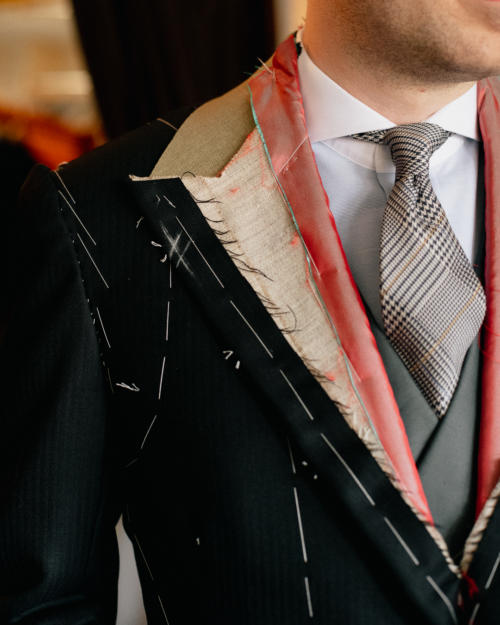
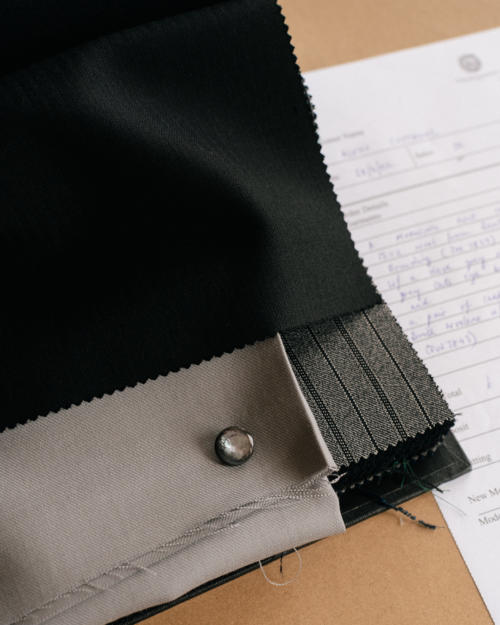
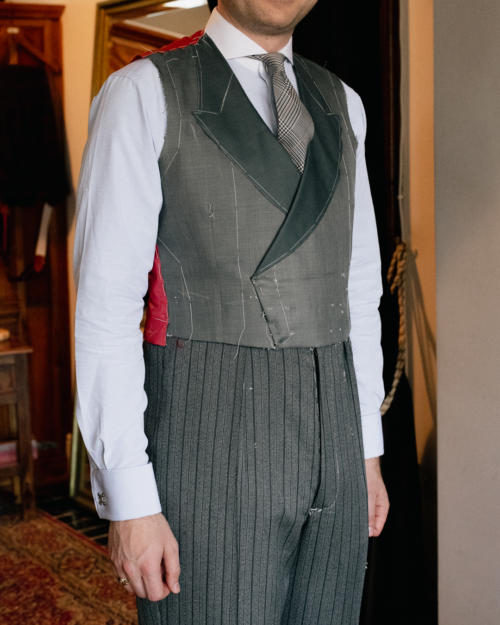
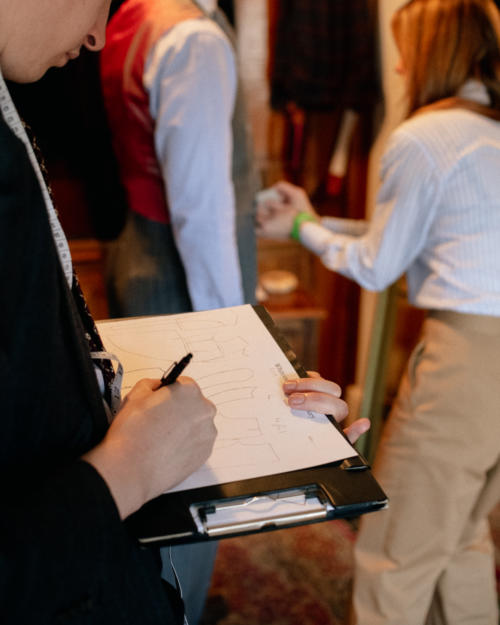
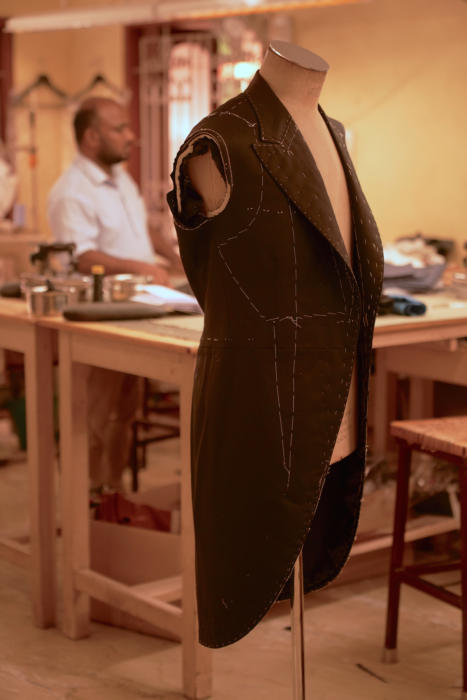
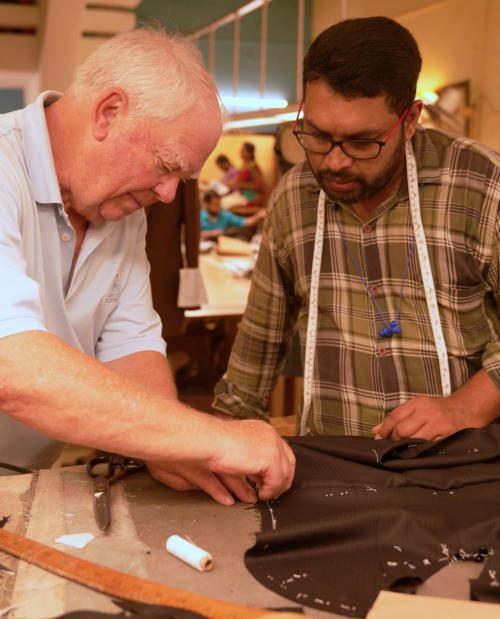
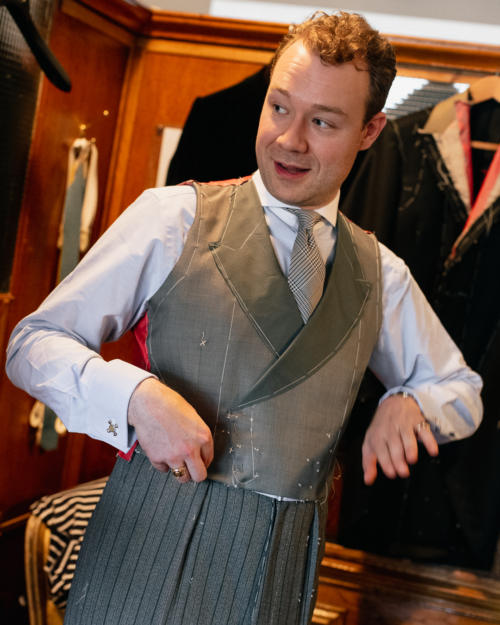
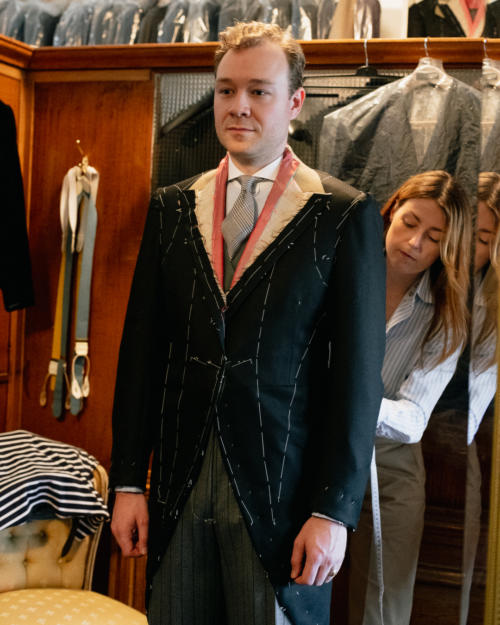
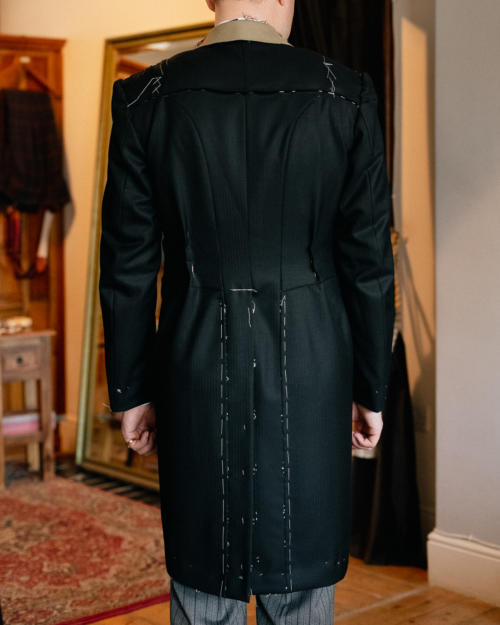
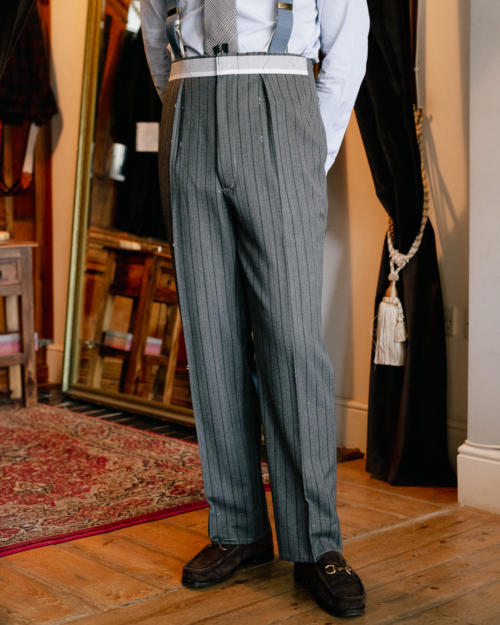
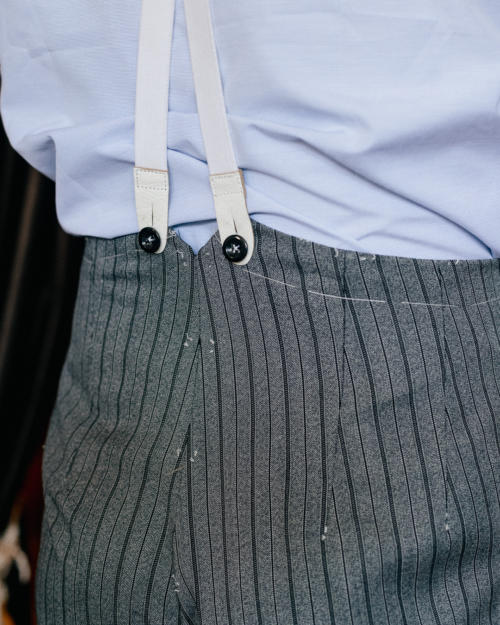
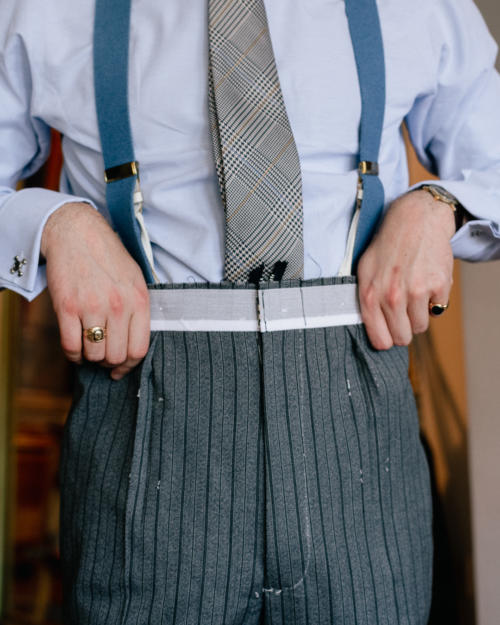
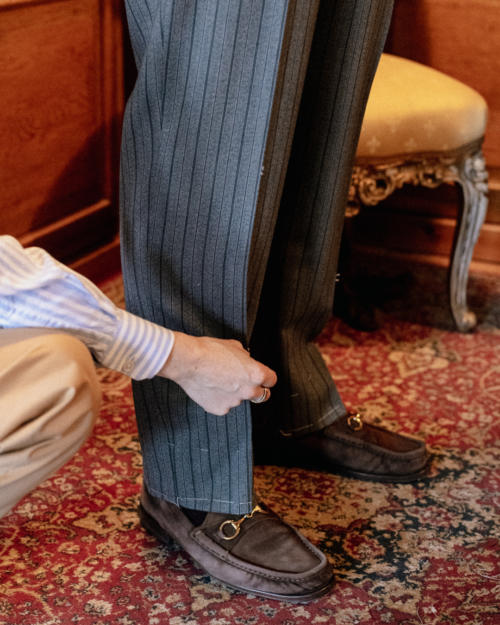


























I know cashmere trousers are the traditional option with a dark morning coat but did you consider just having a pair of plain grey high waisted pants made instead? Personally,I don’t like stripes but my opinion is very subjective.I’m not really sure why I hold this dislike for them!
Hi there. Plain grey trousers aren’t technically “correct” for a morning suit; they need to be either striped or feature a fine pattern like a houndstooth or shepherd’s check. Check out Part One for the details!
Aleks is correct. Plain grey trousers aren’t part of the traditional morning coat outfit. If you wore plain grey trousers with a morning coat to a wedding then people who care about classic menswear would notice this, and would probably assume that you were trying to cut costs by repurposing an existing pair of trousers instead of getting the full outfit. If you don’t like stripes then you can go for a narrower, more subtle stripe or houndstooth. You can also wear a morning suit instead of a morning coat. A morning suit is similar to a morning coat outfit, but the trousers and coat (and possibly waistcoat) are made of the same, lighter grey fabric.
I can’t envisage ever wearing morning dress like this but equally it’s a delightful and very informative series; the writing style at the same time makes interesting reading. A technical question to Alex and/or Simon, please. Looking at the loafers in the photos above would it be best practice to wear the style of shoe intended for the trousers to achieve best fit or is it taken from leg length etc?
Hi there. We’ll cover shoes in part three – these are just what I happened to wear into the fitting, and they’re definitely not ‘correct’ to wear for morning dress. Black Oxfords or button-boots only!
Thanks, Alex. I think however you misunderstood my question. I was asking if at a fitting you can wear just any shoe or whether from a fitting purpose it’s best to wear the appropriate shoes – ie a loafer with a shorter vamp vs a formal Oxford?
Would black Adelaide shoes be acceptable or only Oxfords or button-boots?
Is the price typical for a three piece using their ‘classic bespoke’ service or are you paying more for the additional finishing? Was thinking about commissioning something from W&S soon so just keen to know what their current pricing looks like. Thanks.
Just FYI Matt, I’ve asked Aleks to check on these different questions readers have asked, and I’m sure he’ll reply to everybody.
Cheers
Hi Matt, my understanding is that morning dress is more expensive to order at W&S than a classic lounge suit, given its a very technical garment to produce.
Looking fantastic, great choices. Particularly enjoying your decisions to favour muted moderation – maybe it’s negative associations from rented wedding / Ascot fare, but a grey waistcoat strikes me as much more elegant than the colourful linen numbers you see everywhere. I thought this during the weekend’s Jubilee ceremony at St Paul’s – Charles Will and Harry looked great in their restrained monochrome. (A welcome style win for Will, whose favoured smart-casual look of worsted blue jacket with skinny chinos in a similar blue shade is just awful I think).
Never saw Prince William in skinny chinos, he is is just tall and this may give this impression with normal chinos, and his favoured smart-casual looks with sport jackets and chinos seem absolutely fine to me.
Perhaps, the term “skinny” might be interpreted differently by different people, but I’d say that prince William definitely prefers tight, low-waisted trousers. This has not always been the case. His style changed significantly after his marriage. Whether it’s Kate’s influence, or he was told by someone else to stop wearing clothing that might appear too conservative, as he’s the face of the young generation of the royal family, we don’t know, but his style definitely changed. I, personally, think that the three-button suits he used to wear before the marriage fit perfectly and were absolutely timeless. Ironically, when he was in his teens and early 20’s, he used to wear even more conservative double-breasted suits. Maybe, in a decade or so, we’ll see him transition into a more mature look.
Thanks Peter, glad you like it.
Looks absolutely fantastic Aleks! Good choices!
Thank you!
This is very interesting, having commissioned my own bespoke morning coat from the late Dougie Hayward a few years back (he was still around but Campbell Carey – now Huntsman – was the cutter). My one observation is the choice of feather weave cloth. I was told on no account to choose this as every rental morning coat on the planet is made in this! Instead I chose a plain black which is not only lighter weight which is handy for Ascot and summer weddings, but also drapes beautifully.
Interesting. I guess that each tailor will have their own personal take on this. Personally, I wouldn’t worry about choosing a feather-weave; most bespoke suiting cloths will be of superior quality to their ready-to-wear equivalents. There’s something really lovely about this cloth from Harrisons’ – it has a lovely sheen and very soft drape.
Enjoying this series!
Can you elaborate briefly on what exactly feather-weave is?
Are those shoes horatio?
Yep!
Wonderful read, Aleks, thanks! Cannot wait for the third.
Two points:
– I guess you will speak about the styling there, but I assume for a sombre event, a plain white shirt should do? I know you favour, like the royals, the colourful body with the white collar, but I’m thinking a plain broadcloth white is perfectly correct? Same with choosing a single colour (no pattern) but very formal tie, e.g. satin, would that also work?
– Both the colour/style choices and the fit are perfect: restrained in key aspects (muted dark colours and comfortable fit) but fun around the edges to make an impression that a non-enthusiast will recognise as great but not being able to put a finger on like Simon loves it too (silk braidings – may add those on mine, nicely cinched waist, just so tapered sleeve and leg, interesting stripes…).
How about this for horrific. An unlined cotton morning coat.
https://www.oliverbrown.org.uk/unlined-morning-coat-black-cotton.html
Simon,
i would be interested in your views on the above (unlined cotton morning coat)? I fully understand that they are not traditional, and I would have concerns about the drape. However, as someone who perspires quite a lot and is attending Ascot tomorrow, when temperatures are predicted to be >30 c, I can see an attraction. They also do an unlined linen version. I am thinking about purchasing one for future years. What are your views. Is there a better material you can recommend to have made bespoke by someone like Graham Brown?
Many thanks
I would stick with the traditional materials and lining Richard. You’re only going to have one, and it won’t always be 30 degrees
Thanks Simon. Out of interest, do you think cotton or linen is a better material for a jacket in warmer weather. Does cotton crease as much as linen?
No it doesn’t, but it’s not as elegant either. It’s more casual, it has its own distinctive character. That’s a better way to think about it rather than better or worse
I see after the fact that the dress code was relaxed – hats and jackets could be removed.
https://twitter.com/ascot/status/1537736554747244546
OTOH, pics like this do make me slightly wonder about dress codes. I’m glad they look like they’re having fun, but less that wonderfully fitting rental outfits don’t really make for an excess of elegance, IMHO.
https://twitter.com/victoriacoren/status/1537868057888149506
You may not be able to recognize a quality difference, and may have very little time for it, but there is nothing wrong with someone acknowledging that offshoring production is detrimental to local workers and the traditional bespoke craft.
That’s a great tie – where is it from?
Has the third instalment been banned by your sociologists friends?
The third installment is coming soon